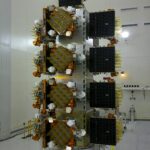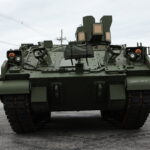
After releasing the most extensive details to date on its $961.6 billion fiscal year 2026 budget request, the Pentagon on Thursday defended its decision to factor in anticipated reconciliation funds for the spending boost citing the flexibility and lengthier amount of time to spend those dollars.
The move to combine an $848.3 billion in discretionary spending with $113.3 billion in mandatory funding from the pending reconciliation bill for its budget submission has received pushback from lawmakers, including Republicans, with the Pentagon putting its entire $25 billion Golden Dome request and plans to build 16 new Navy ships in the reconciliation portion of the request.

“[Reconciliation funds are] 10-year money with a lot more flexibility than the average discretionary dollar provides. It’s often colorless. And it gives us that 10-year window that industry often asks us for, a longer-term window than the one-year budget cycle that we always are on,” a senior defense official told reporters at a briefing on the department’s budget request.
“Given the timeline that the reconciliation [bill] is on, should it pass, it would be delivered faster to the department than the FY ‘26 discretionary base [spending]. So those programs will actually be on a much faster and more stable timeline with a better demand signal [to industry] over the long term,” the official added.
The White House in May rolled out a “skinny” budget outline for FY ‘26, touting an “unprecedented” 13 percent boost in defense spending, while the proposed $1 trillion total national defense topline factored in the $113 billion increase that would come from funds in the pending reconciliation bill (Defense Daily, May 2).
Congressional Republicans are currently pressing ahead with plans to finalize and pass the massive reconciliation over the next few weeks, which includes a defense portion totaling $150 billion that would be allocated over the next fours and builds in flexibility to be spent over the next decade.
“What we’ve been saying is [it’s a] one budget, two bills approach for the FY ‘26 budget,” the senior defense official noted.
Sens. Roger Wicker (R-Miss.) and Mitch McConnell (R-Ky.), respective chairs of the Armed Services Committee and Appropriations Defense Subcommittee, have both called the move a “budgetary sleight of hand” and pushed back on the FY ‘26 budget request essentially representing a flat request, or a cut when factoring for inflation, when taking the reconciliation funds out of the equation (Defense Daily, June 4).
“There are some members of the administration who thought we would be delighted with the $1 trillion [defense topline request]. That’s not the way we viewed it. We need a steady increase in terms of the baseline [budget] year after year after year to get where we need to get. And we need to get to five percent [of] gross domestic product,” Wicker has said previously. “We view reconciliation as a major opportunity to try to catch up, but it makes no sense then to have a flat budget.”
A budget document the White House submitted to Congress earlier this month outlined several major programs where the Pentagon was planning to utilize anticipated reconciliation funds for large portions or, in some cases, all of the funding, to include the entirety of the Pentagon’s $25 billion FY ‘26 request for the Golden Dome missile defense project (Defense Daily, June 11).
“The president and the administration’s commitment to reconciliation is what led the department to be so confident in putting so many critical capabilities in the reconciliation bill, knowing that there will be a question on how we’re going to pull the rabbit out of the hat again [next year],” the senior defense official told reporters.
Newly published budget documents show that more than half of the Navy’s $47.3 billion shipbuilding request for FY ‘26 is on the reconciliation side, covering funds for 16 of the 19 total new ship procurements.
Specifically, the Navy request $26.5 billion on the reconciliation side for 1 Virginia-class submarine, two Arleigh Burke-class destroyers, one San Antonio-class Amphibious Transport Dock (LPD) ship, one America-class Amphibious Assault Ship (LHA), nine Landing Ship Mediums and two Fleet Replenishment Oilers.
The discretionary base budget portion of the request covers three ships, a Columbia-class submarine, another Virginia-class submarine and one T-AGOS surveillance ship.
“I think for all of us, it’s helpful to talk about these together because I think it does confuse industry when we talk about, ‘Well, it’s in this bill or that bill.’ And this is our [president’s budget request,] these two bills,” a senior Navy official said.
The current defense portion of the reconciliation bill set to be considered by the Senate does not include the requests for the LHA and LPD after originally being included in the version passed by the House.
“In terms of what the plan is if reconciliation does not pass, at this moment we’re very excited to see the Senate’s progress on reconciliation. [We’re] very happy that the House has been collaborating on the defense portion. And we have been working with HASC and SASC on the defense portion as well,” the senior defense official said. “This is our request for what we would like to see in reconciliation and what we’d like to see in the discretionary base [budget], and it will go through the normal congressional budgeting process from here and we’ll work with Congress on the details and why the department is requesting certain things in our $961 billion request.”
The House Appropriations Committee on June 12 passed its $831.5 billion FY ‘26 defense spending bill, which it wrote and approved before having received full budget details from the White House (Defense Daily, June 13).

 By
By 











